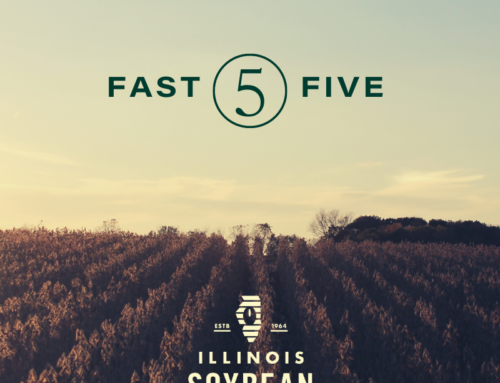FOR IMMEDIATE RELEASE
SOYBEAN NUTRITIONAL VALUE REMAINS FRONT AND CENTER FOR THIS ILLINOIS PRODUCER
BLOOMINGTON, ILL. – April 20, 2020 – Despite a challenging growing season in 2019, Illinois soybean producer Don Guinnip was still able to achieve good yields and at the same time grow soybeans that ranked high in livestock nutritional value.
In fact, the quality of his soybeans was so high that Guinnip was recognized by the Illinois Soybean Association (ISA) High Yield PLUS Quality (HY+Q) initiative for outstanding livestock feed quality. He also received a national U.S. congressional citation from Illinois Republican congressman John Shimkus of Collinsville that was entered into the Federal Register in recognition of his exceptional soybean quality.
While these achievements would be noteworthy for any given growing season, they are especially so for a year that challenged and confounded soybean producers across the Midwest. Many farmers in 2019 were unable to get crops planted on time – or even planted at all – and yields suffered accordingly.
Guinnip farms in Clark County in the Wabash River Valley near Marshall, Ill. The incessantly wet and cold spring last year threw a monkey wrench into efforts to get corn and soybeans planted in a timely manner. All of Guinnip’s corn was planted in June, and he didn’t finish planting and replanting soybeans until July 12. Not surprisingly, he finished harvesting soybeans at Thanksgiving and corn in mid-December.
The livestock feed value of soybeans is vitally important because 70 percent of soybeans produced in the U.S. are used to feed livestock, including swine, poultry, dairy and beef cattle. Soybean feed value is determined by the levels of seven essential amino acids that drive animal growth, productivity and profit for the livestock producer.
The ISA HY+Q initiative is a soybean checkoff-funded program that has analyzed over 50,000 samples over seven years and developed ranking methodology to determine livestock nutritional value across hundreds of the most popular soybean varieties available today. The overall objectives of HY+Q are to supply farmers with this critical information and encourage them to select and plant those varieties with high nutritional value.
“Knowing the value of your soybeans doesn’t just mean having a handle on yield, protein and oil,” Guinnip says. “You have to also focus on those key amino acids that determine feed value and drive market demand.”
The winning soybean varieties for Guinnip included Stine Seed Company’s 34LE32, a short-season variety planted in July that produced protein scores well above both the Illinois and U.S. averages; and 38LE02, another short-season variety planted in July which ranked very high in amino acid content and oil, but low in protein.
“Soybean quality is affected not only by genetics, but also by environmental factors and stressors,” says the Illinois producer, who has submitted soybean samples for nutritional analysis the past seven years. “The crazy weather patterns in 2019 had more of an impact on quality than a normal growing season ordinarily would have.”
Guinnip feels strongly that planting high-quality soybeans is one of the best steps that farmers can take to recapture and grow market share in critical livestock feed markets. Since 1990, the use of soybean meal in livestock feed rations has dropped 70 percent and been replaced by synthetic amino acids. “I want to be part of the solution, not part of the problem,” he says.
Austin Rincker, an ISA director and soybean-livestock producer in Moweaqua, Ill., says that Guinnip is a highly successful and detail-oriented farmer who is heavily committed to advancements in agriculture and to his fellow farmers.
“We can no longer afford to look at soybeans as just another commodity crop,” Rincker explains. “Instead, we have to look at new ways to extract value from the soybeans we grow, and that means increased focus on improving nutritional value and amino acid profiles. This is one of the best ways to protect our markets from use of synthetic feed ingredients and competition from other countries, most notably South America.”
Rincker gives ISA and the HY+Q program high marks for its innovative approach to improving soybean value and encouraging farmers to plant those soybean varieties that best serve the unique needs of livestock producers – the industry’s single largest customer. “This program is at the forefront of the effort to improve soybean quality, and this is the direction that the soybean industry needs to go,” he observes. “We are seeing increased interest and involvement by seed companies and other suppliers in the soybean value chain, and what ISA is currently doing is just the tip of the iceberg.”
The Illinois Soybean Association (ISA) checkoff and membership programs represent more than 43,000 soybean growers in Illinois. The checkoff funds market development, soybean innovation and profitability efforts, issues analysis, communications and education. Membership and advocacy efforts support Illinois soybean farmer interests in local areas, Springfield and Washington, D.C. through the Illinois Soybean Growers. ISA programs are designed to ensure Illinois soy is the highest quality, most dependable, sustainable and competitive in the marketplace. For more information, visit the website www.ilsoy.org.
-30-
For more information contact:
Rachel Peabody
Communications Manager
Illinois Soybean Association checkoff program
Illinois Soybean Growers
peabodyr@ilsoy.org
309-808-3617

